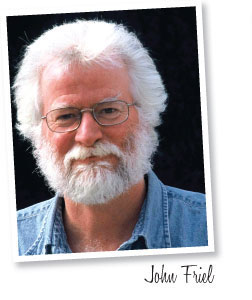10/1/2020
Com-pair-isons
John Friel

New plants are, as Dr. Allan Armitage says, “the lifeblood of the industry.” We’re fortunate to have many lifeblood donors, i.e., innovative breeders and discoverers.
Frankly, gardeners care less than we do how “new!” a variety is; civilians have only the vaguest idea how all that color magically appears at retail. But new stuff keeps professionals motivated and ultimately benefits even the most clueless consumer. Here are a few of the neatest new-ish things I’ve seen recently.
Amsonia x Butterscotch vs. A. hubrichtii
I rarely dis a Perennial Plant of the Year winner, especially one as cool as Amsonia hubrichtii, but Butterscotch is an upgrade. The foliage color is richer, both green and in its golden autumnal glory. And there’s no tip die-back, which doesn’t seriously dampen the charisma of A. h. planted en masse; frankly, I never noticed the original’s ugly tips until this one came along. But once seen they can’t be unseen.
Agastache Crazy Fortune
I’m a little surprised this one got PBR certification in Europe, where they’re allegedly more fussy about stable variegation. The leaf edge starts purple and then goes white, but it’s erratic and sometimes missing entirely in trials in Pennsylvania and Florida. Call me crazy, but I love it anyway. The flowers just don’t quit from early summer to hard frost and pollinators are nuts about them.
Miscanthus Encore
This Hans Hansen-bred variety is striking, with dazzling silver/white mature inflorescence and neat habit. But you could say that about many maiden grass varieties. This one’s claim to fame, and the reason for its name, is that it blooms early enough for northern gardeners to enjoy, then sends up a second flush. I’ve seen it only in trials, as my employer doesn’t offer it. It’s worth a second look.
Echinacea Red Ombre
The ladies in the audience will snicker, but I though “ombre” was a variation on Hombre, pardner. Nope. It’s that eye-catching, multi-tone hair dyeing technique. Which suits this PanAmerican Seed variety perfectly. Flowers soften with age from bold red to softer reds and near-orange. Touted as the first F1 hybrid echinacea, Red Ombre scored an impressive 4.16 out of 5 in Penn State trials.
Lomandra (Mat rush) Baby Breeze & Wingarra
The Jiminy Cricket on my left shoulder is a perennial purist. The one on my right is a marketing pragmatist. When I first saw this tender (Zone 9) genus at the Farwest show a few years ago, one Jiminy hissed “Resist!” while the other purred, “Dude, it’s cool! Who cares if it’s hardy?”
That question once made me cringe, but I’ve reluctantly embraced the annualizing of perennials, i.e., planting hardy species in containers that get tossed at season’s end. Heuchera, lysimachia, rudbeckia, even echinacea—any foliage-forward or long-flowering perennial fits this troubling, but profitable, strategy. But I digress.
These Aussie imports barely qualify as “new.” Wingarra (SIR5) was patented in 2008, Baby Breeze (LM600) in 2017. But they’re not well known or widely available here, yet. They’re not as showy as Pennisetum x advena Purpureum and Fireworks, but they’ll make interesting, guilt-free container filler.
Pennisetum alopecuroides Yellow Ribbons + P. Lumen Gold (JS Jommenik)
For every gardener who loves how golden foliage lights up a border, there’s another sneering, “Hey, that thing’s chlorotic. Feed it!” Ignore him. Gold is where you find it. We grow Yellow Ribbons, selected in Illinois by Brent Horvath, but not Lumen Gold, a Belgian discovery. Either should make a cool foil for familiar P. Hameln. I'd love to compare them side-by-side, but haven’t seen that pairing yet. Next October, maybe This Space can provide an update. GP
John Friel is marketing manager for Emerald Coast Growers and a freelance writer.